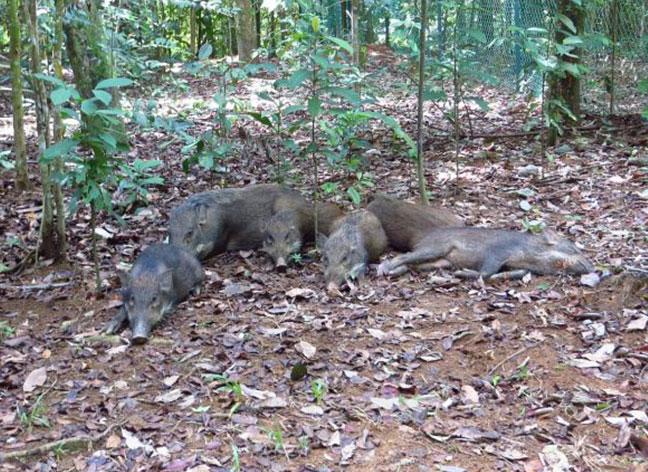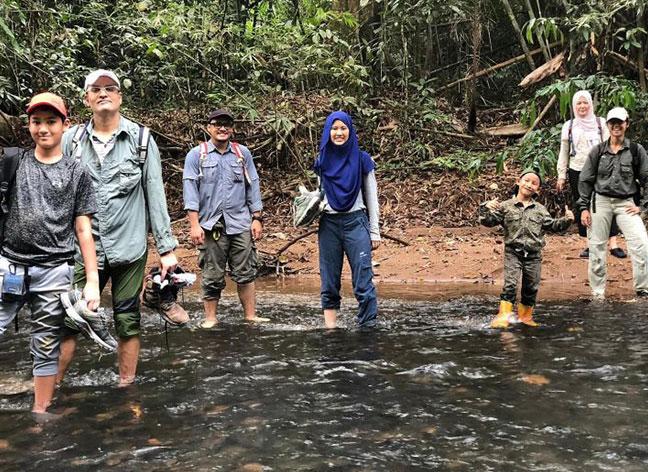"Tiger shark, doo doo doo doo doo doo."
The all-too-familiar strains of Baby Shark - albeit a reworked version of the viral children's song - are emanating from a video. Besides singing children, it features stop-motion animation using pictures of different kinds of sharks, which were painted by these pre-schoolers.
Produced by kindergarten pupils and their teacher at EtonHouse Pre-School in Vanda Road two years ago, the video was part of WWF-Singapore's anti-shark fin campaign on social media last year.
One of the children involved, Lily Huang, now seven, still remembers what she learnt from the project. "We shouldn't kill sharks because they are important to the environment," says the Primary 2 pupil.
More wildlife programmes, aimed at empowering children to protect the environment, have sprung up in recent years, from those educating people to say no to shark's fin soup to saving the Malayan tiger.
The trend is fuelled by reports of human-wildlife encounters, industry insiders say.
Talk to children about wildlife
-
Conservation experts share tips on how to talk to children about wildlife and even get them to start their own eco project.
Animals have families too
-
"When humans get into unpleasant encounters with wildlife, such as wild pigs or long-tailed macaques, help children understand that animals are not evil or aggressive. Help them relate such incidents to family life, which animals have too. For instance, animals need to protect their babies and may think people who come near are trying to harm their babies." - Dr Vilma D'Rozario, director of Singapore Wildcat Action Group (Swag)
Using one's senses to engage wildlife
-
"We introduce pre-schoolers to wildlife through sensory activities, which give them an interest in the topic. Eventually, they will want to learn more and come back.
-
"For instance, most young children can't identify the bird calls they hear in daily life. Now when they hear the sound of the koel in the morning, they can tell their parents what bird it is." - Mr Raj Kumar Sandrasegeran, education executive at Animal Concerns Research and Education Society (Acres)
Design a nature trail
-
"Guide your child in designing his own nature trail. Download the Seek app by iNaturalist to discover and identify wildlife in your neighbourhood park.
-
"With a camera or mobile phone camera, notebook and pencil, walk around your chosen area, taking notes, photos and sketches. Draw a route map as you explore. Look out for trees, fruit, flowers or logs that may house insects as well as interesting rock arrangements.
-
"Add challenges to your trail by creating a quiz or treasure hunt. Make signposts if you like, but remember to remove them afterwards. Invite others to enjoy the trail and don't forget to pack water and snacks." - WWF-Singapore
Venessa Lee
Acres (Animal Concerns Research and Education Society), an animal protection organisation, gave 86 talks at schools so far this year, compared with 70 in 2017, says Mr Raj Kumar Sandrasegeran, its education executive.
"The surge in demand is because wildlife issues are being discussed more these days in mainstream and social media," he adds, citing roadkill incidents and snake sightings.
As a result of this growing awareness, he says, many schools have been approaching Acres for educational workshops, talks and visits, while parents also want their children to learn more about native animals.
Last year, there were at least three reported incidents of wild sambar deer dying after being hit by vehicles in the Mandai Road area.
In January this year, a 3m-long python drew a crowd of shocked passers-by when it was sighted at Tang Plaza in Orchard Road.
Conservation organisation WWF-Singapore has seen "increased interest among Singapore schools for long-term, real-world engagements", says its head of education, Ms Chitra Venkatesh.
Since 2013, through its Eco-Schools programme, WWF-Singapore, which is part of World Wide Fund for Nature's (WWF) global network, has reached out to 100,000 students each year, in pre-schools, primary and secondary schools, as well as three ITE (Institute of Technical Education) campuses.
Eco-education is no longer optional for this generation of young people, says Ms Venkatesh.
"Environmental education is no longer a 'good to have' for youth. They have a real stake in the world that they are about to inherit and are speaking out louder than the world leaders of today on critical environmental issues," she says.
Swedish teenager Greta Thunberg, 16, has been in the news for speaking out about the need for urgent action to combat climate change.
In urban Singapore, where some are uncomfortable with nature, introducing children to wildlife can be a gateway to teaching them about related environmental issues.
Ms Teresa Teo Guttensohn, president and co-founder of Cicada Tree Eco-Place, which focuses on environmental education, has seen primary school-aged children who "scream when they see a butterfly".
Getting children to learn about flora and fauna should be "through direct interaction", she says. "It promotes conservation of our local biodiversity, which has something to do with how we live."
People in Singapore use about 2.2 million straws daily, according to a study last year. Such plastics can end up in the sea, affecting turtles that ingest them.
At an overnight camp at Pulau Ubin organised by Cicada Tree Eco-Place during the June school holidays, Ms Wang Shan Shan's three children - especially her youngest, seven-year-old daughter - were thrilled to look for birds' nests, snakes and eagles on their guided visit. "We may not be aware that Singapore has a lot of nature and wildlife. It creates awareness and helps us be more eco-conscious," says Ms Wang, 45.

In a 2015 photo of a trip organised by Cicada Tree Eco-Place, a family of wild pigs was spotted taking a mid-day snooze at Chek Jawa, Pulau Ubin.PHOTO: CICADA TREE ECO-PLACE
Besides cultivating habits such as recycling, their family is aiming to cut down on food waste, says Ms Wang, who works in banking.
Some new conservation groups are focusing not on local wildlife, but more exotic creatures.
Singapore Wildcat Action Group (Swag), founded early this year, promotes awareness of wildcats and raises funds to save the Malayan tiger, a sub-species.
Fewer than 4,000 tigers remain in the wild globally and there are fewer than 200 wild tigers in peninsular Malaysia. Poaching, habitat loss and the illegal wildlife trade drive this decline.
Besides launching two children's books on Little Tiger and his adventures next month, Swag coordinates trips for families with children as young as six to Sungai Yu Tiger Corridor, a narrow stretch of forest that borders Taman Negara National Park in Pahang, Malaysia. This Saving Tigers Together Family Outreach programme is organised by Mycat, a Malaysia-based alliance of groups focused on tiger conservation.

In the Saving Tigers Together Family Outreach programme, children and teens up to 17 years old travel to forested areas in Pahang, Malaysia, to spot signs of poaching. PHOTO: VILMA D'ROZARIO
Two of these trips have been organised so far, during the March and June holidays this year, says Dr Vilma D'Rozario, a director at Swag.
These trips, which involve wildlife officials and local orang asli guides, are aimed at deterring poachers and removing animal traps and snares. Participants can catch a glimpse of wildlife such as hornbills, leopard cats and common palm civets, says Dr D'Rozario, who has seen prints left by sun bears, elephants and tapirs in the forests of Pahang.
Learning to protect an apex predator like the critically endangered tiger teaches young people and families about the interlinked web of conservation, says Dr D'Rozario.
The extinction of such a predator at the top of the food chain would impact the number of tiger prey such as sambar deer and wild boars, and disrupt the entire eco-system as the forest is a water catchment area for humans. "Understanding wildlife and their habitats is knowledge that can be related back to Singapore. For example, we don't throw rubbish into drains that go into the sea," says Dr D'Rozario.
Secondary 1 student Sumayyah Mohd Zaki comes from an outdoorsy family. With her parents, she has hiked in places such as Nepal and Mount Kinabalu and dived in Tioman and the Maldives.
But the outdoor adventure presented by the Saving Tigers Together Family Outreach trip, which the only child took with her parents in March, was different.
"The aim was not for a personal cause. When you're diving, you want to see the different types of rays and sharks. When you're climbing a mountain, your aim is to reach the summit," says Sumayyah, 13.
"Here, you don't know where your conservation efforts will lead. You have to work hard and persevere. But you know the tigers are safer when you're supporting such anti-poaching efforts."
This article is produced in partnership with ST Life.
